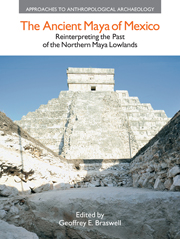Book contents
- Frontmatter
- Dedication
- Contents
- Contributors
- List of Figures
- List of Tables
- 1 The Ancient Maya of Mexico: Reinterpreting the Past of the Northern Maya Lowlands
- Part I THE PRECLASSIC PERIOD
- Part II THE EARLY AND LATE CLASSIC PERIODS
- 5 Urbanism, Architecture, and Internationalism in the Northern Lowlands during the Early Classic
- 6 The Political and Economic Organization of Late Classic States in the Peninsular Gulf Coast: The View from Champoton, Campeche
- 7 5,000 Sites and Counting: The Inspiration of Maya Settlement Studies
- Part III THE TERMINAL CLASSIC AND EARLY POSTCLASSIC PERIODS
- Part IV THE LATE POSTCLASSIC TO HISTORICAL PERIODS
- Part V CONCLUSIONS
- Index
5 - Urbanism, Architecture, and Internationalism in the Northern Lowlands during the Early Classic
from Part II - THE EARLY AND LATE CLASSIC PERIODS
- Frontmatter
- Dedication
- Contents
- Contributors
- List of Figures
- List of Tables
- 1 The Ancient Maya of Mexico: Reinterpreting the Past of the Northern Maya Lowlands
- Part I THE PRECLASSIC PERIOD
- Part II THE EARLY AND LATE CLASSIC PERIODS
- 5 Urbanism, Architecture, and Internationalism in the Northern Lowlands during the Early Classic
- 6 The Political and Economic Organization of Late Classic States in the Peninsular Gulf Coast: The View from Champoton, Campeche
- 7 5,000 Sites and Counting: The Inspiration of Maya Settlement Studies
- Part III THE TERMINAL CLASSIC AND EARLY POSTCLASSIC PERIODS
- Part IV THE LATE POSTCLASSIC TO HISTORICAL PERIODS
- Part V CONCLUSIONS
- Index
Summary
Abstract
Scholars have long recognized the Late and Terminal Classic periods in northern Yucatan as times of dynamism and cultural florescence. Meanwhile, recent research on the Preclassic reveals that this era witnessed a surprising degree of social complexity. Bracketed by these two exceptional chapters in Yucatecan prehistory, the Early Classic period can come across as a lull, with declines in settlement reported for some areas. Nonetheless, a growing body of data shows that the Early Classic saw a number of exciting developments, such as the appearance of the first urban centers and the intensification of interregional interaction. This paper discusses examples of these integrations as seen especially from the perspective of Chunchucmil, Izamal, and Uci.
“The Early Classic Maya in the north were not country bumpkins living in the backwaters of the Maya world” (Bey 2006:36).
The Late and Terminal Classic periods in the northern Maya lowlands have long attracted the attention of both scholars and tourists because of the growth of massive cities, the florescence of a regional architectural style, and an embrace of international contacts extending to central Mexico and beyond. This was not the first time, however, that the peninsula experienced such developments. In this chapter I discuss urbanism, distinctive regional architecture, and internationalization in one of the least known periods in Yucatan, the Early Classic (Glover and Stanton 2010:60). In demonstrating these remarkable developments, I draw heavily on data from two projects with which I have been affiliated—the Pakbeh Regional Economy Program (PREP) at Chunchucmil and the Uci/Cansahcab Regional Integration Project (UCRIP).
- Type
- Chapter
- Information
- The Ancient Maya of MexicoReinterpreting the Past of the Northern Maya Lowlands, pp. 119 - 142Publisher: Acumen PublishingPrint publication year: 2012



